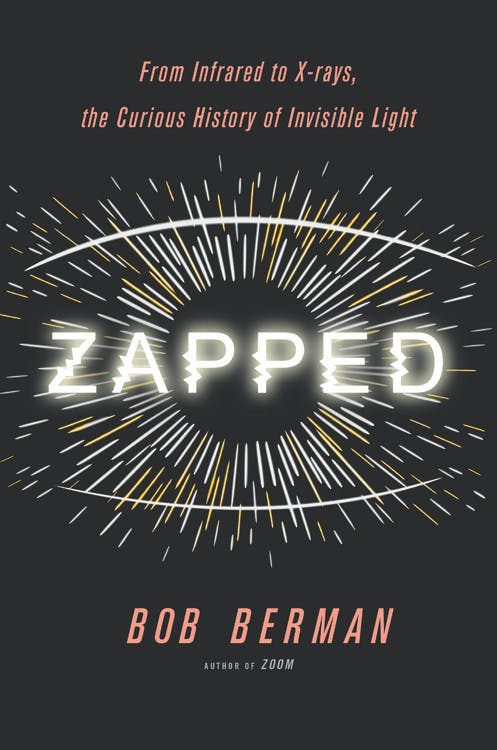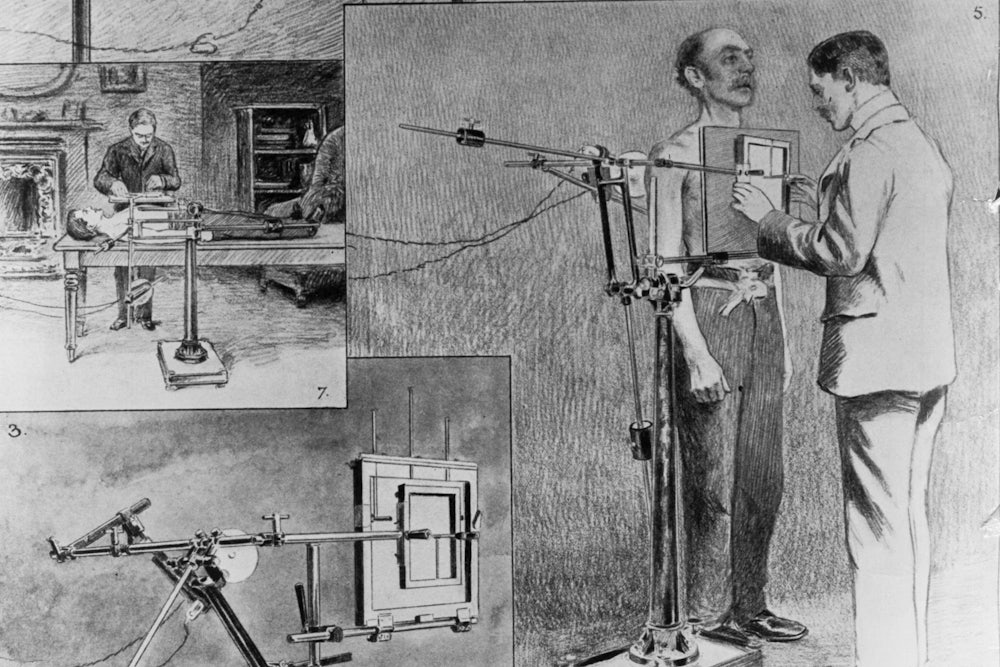In November, 1895, Wilhelm Röntgen made an unusual discovery: He’d taken a glass vacuum tube, through which he’d run a high voltage currency, and covered it in black cardboard so none of its light could escape—and yet, when he turned off the lights to his lab, he found a paper plate coated with barium six feet away from the tube glowing. Röntgen didn’t immediately understand what was happening, so he tried different experiments, before finally, on December 22, he put his wife Anna’s hand in the path of the tube, with a photographic plate set up behind it. When he developed the photograph, it revealed her bones and her wedding ring, but none of the rest of her hand. When Röntgen showed his wife the world’s first X-ray, she screamed, “I am seeing my own death!”

Wilhelm and Anna were among the lucky ones. Because of Anna’s initial fright, Wilhelm took precautions to minimize his exposure to these strange new rays, and both lived well into their seventies. But as Röntgen’s technology spread (he refused to patent it), it quickly became ubiquitous as both a medical technology and an entertainment. In May of 1896, Thomas Edison set up a display at the National Electric Light Association exhibit in New York City, where visitors could hold their hands under an X-ray and see their bones on a glowing screen. In addition to their obvious medical use and novelty entertainment value, X-rays were touted as having medicinal properties as well: They could restore sight, rejuvenate the body, destroy any and all pathogens.
Certainly, there were reports that the skin exposed to X-rays often burned, or hair fell off, or developed necrotic lesions, but these were mostly ignored. Clarence Dally, a worker at Edison’s lab who tested each and every tube by placing his hands under the beam at full strength, first burned his hands, then had one—and then the other—arm amputated, before dying at the age of 39 in 1904, but this was a one-off. It was over 25 years before it became clear beyond a shadow of a doubt what we now know: that X rays have a powerful ability to disrupt cell tissue at the molecular level, and excessive exposure quickly leads to burns, hair loss, and potentially death. Anna Röntgen wasn’t too far off.
Bob Berman’s Zapped: From Infrared to X-Rays, the Curious Story of Invisible Light, tells the story of Röntgen’s rays, alongside so many other invisible waves we now take for granted. Despite the horrors of early X-ray usage, Berman assures us that “the main takeaway from this book is certainly not that we should be fearful. Rather, my purpose has simply been to open a window onto the enormous universe of omnipresent energies, most of them benign, that fill every moment of our lives.” Perennially curious and fascinated by this invisible world, Berman wants to bring to light these strange photons and wavelengths that went unseen for centuries, giving us insight into how they make and transform our world.
One of Zapped’s strengths is its reminder that so much of science involves fumbling, as it were, in the dark. Röntgen’s story is one of a handful in Zapped that chronicles how an unlikely experimenter discovered a new form of invisible light: infrared, ultraviolet, radio and microwaves, and alpha, beta, and gamma rays. William Herschel, for example, first discovered infrared in one of those great accidental moments. He’d been measuring the temperature output of sunlight from various bands on the color spectrum split by a prism, and had taken a break, leaving his equipment unattended. By the time he returned, the sun had moved enough that his thermometer that had been in the red band of the prism was now in the shadows just outside the red band—and yet, it registered a hotter temperature than any others in the spectrum; it was Herschel’s first clue that there were rays from the sun that were invisible to the naked eye, rays that could cause heat, which he terms “calorific rays” and later became known as infrared.
In addition to offering a history on how these various waves were discovered, Berman gives readers a primer on how each of them work—why, for example, UV rays are harmful to the skin while infrared is not. (UV rays are much smaller, which means they pulse at an exponentially greater frequency, vibrating atoms more energetically and thus having the potential to disrupt cells). Like any good pop science book, along the way Zapped offers an endless series of tidbits, from how GPS works to how a software glitch led to the worst incident of radiation poisoning from a medical device (the notorious Therac-25). Berman explains that the sky is actually violet, but since humans, unlike most other animals, have a more limited capacity to register that end of the spectrum, we see the next most prevalent color in the sky: blue. Meanwhile, because green is in the middle of our color spectrum, we’re far more adept at identifying different shades of it than any other color.
As Berman notes, the first such form of invisible light (infrared) was discovered by Herschel in 1800; the last (gamma rays) by Paul Villard in 1900. An even hundred years encapsulates the entire history of this invisible terrain. But in a far more real sense, it is the twentieth century that was the time of invisible light. It was the twentieth—not the nineteenth—that saw all of the great technological advances made possible by invisible light, such as radio and microwave ovens, remote controls and medical imaging. And it also became familiar with all of the dangers associated with these hidden wavelengths. It was the century that saw increased skin cancer from UV exposure, radiation poisoning, and the disasters of Chernobyl and Hiroshima.
Beyond the physical impacts these waves have had on our bodies, they’ve changed the way we view the world. Invisible waves have changed the scope of the world, bringing us closer through radio and satellite technology, exposing what was once hidden through sonar and radar technology, and they’ve taught us to fear what we can’t see.
They’ve also taught us to rethink the body itself: nothing is quite as an uncanny as seeing one’s own X-ray, and seeing one’s flesh and features obliterated to reveal an anonymous skeleton. By radically reducing the body to nothing more than its bones, X rays dissolved one’s entire identity—a denuding that shocked and scandalized. As Lisa Cartwright explains in her Screening the Body: Tracing Medicine’s Visual Culture, fin de siècle commentators often expressed a “pervasive cultural anxiety over the X ray’s perceived capacity to dissolve sexual identity by figuratively decomposing the organs and flesh. At stake is the loss of the cultural text inscribed in the skin, the organs,” a loss, she concludes, of “the presence of a surface that conceals living structure, a signifying surface of clothing or skin that can be read for signs of sexual and cultural difference.” It’s not a coincidence that the iconic image associated with X-rays (one often imitated) is of a hand with a wedding band, as though to assert gendered roles in even the most ghostly of photographs.
Berman himself never gets too far into these topics, but they lurk, all the same, just out of sight throughout Zapped. The history of invisible light is ultimately more than simply a history of technological discovery; it opens up news ways of thinking just as it closes others. These discoveries also helped bring to an end The Enlightenment—or at least, one of its central metaphors. For over a century, Enlightenment thinkers had relied on sight as the central metaphor for knowledge (it’s there in the very name of the movement), but what Herschel, Röntgen, and Curie all revealed is that some of the most powerful things on Earth exist beyond sight. Even perfect vision does not know all. In his book Downcast Eyes, Martin Jay notes that by the twentieth century, philosophy (particularly in France) “is in one way or another imbued with a profound suspicion of vision and its hegemonic role in the modern era.” It’s hardly coincidental that an age of invisibility would send its scholars in search of new metaphors for knowing.
Berman’s history ends with the present, where he discusses, among other topics, ESP and cell phone usage. For a science writer, he’s surprisingly bullish about the possibility of ESP. He throws in personal stories of dubious significance. Recounting an anecdote in which he guessed his opponent’s Scrabble play seconds before the word was laid down, Berman claims, improbably, that “Advance perception of such an unlikely event in two different people, at the exact same moment in time, seems too improbable to dismiss as bias selection.” After a few such thin examples, Berman confesses, “I simply cannot fully dismiss the possibility of ESP,” a disappointing admission from a science writer—precisely because he admits that such an effect cannot be duplicated in laboratory settings, and thus resorts to needlessly privileging anecdotal evidence over anything approaching science.
At the same time, he’s dismissive of fears that widespread cell phone use may cause harm. It’s true, nearly all of the available science on the matter agrees that we have yet to see any measurable health effects from cell phone use. But it seems odd—in a book detailing not only the harm of X-rays but the fact that this harm was unknown and/or ignored for almost thirty years before being understood—Berman would be so confident about the safety of as-yet-untested technology. The future of invisible light, it appears, remains to be seen.
